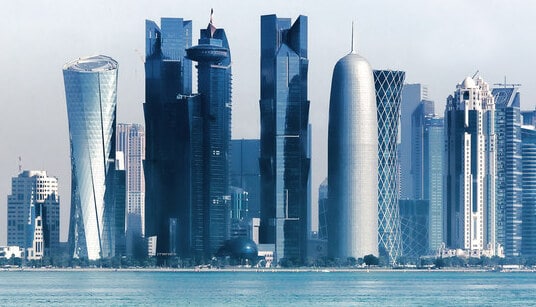In April, Qatar achieved a trade balance surplus of $6 billion.
Qatar’s economy showcased resilience in April 2023 as the country recorded a trade surplus of 22 billion Qatari riyals ($6 billion), according to a report released by the states’s Planning and Statistics Authority. This figure represents a 3.5 percent increase over the previous month, while showing a decline of 35.6 percent compared to the same period last year.
The report highlights the economic dynamics of the states’s trade balance, revealing a decrease in the value of merchandise imports during April 2023. Imports fell by 6.3 percent from the previous year and 9.3 percent from the previous month, reaching an estimated 8.7 billion riyals. This decline could be attributed to various factors, including global economic conditions and efforts to diversify the states’s economy.
In contrast, the country’s exports of oil, gas, and condensate experienced a significant drop in April, totaling 18.6 billion riyals. This figure represents a decrease of 33.2 percent compared to the same period last year. The decline in export value can be attributed to various factors, including fluctuations in global oil prices and production levels.
The report also shed light on the key destinations for the country’s exports in April, with China and South Korea emerging as major trading partners. Together, these two countries accounted for over a third of the states’s total exports during the month.
China secured the top position as the largest recipient of the states’s exports, with a total value of 5.6 billion riyals, representing 18.3 percent of the overall export value. This strong trade relationship with China can be attributed to state’s abundant energy resources, as China continues to be a significant consumer of oil and gas.
South Korea, on the other hand, claimed the second spot with 5.1 billion riyals in exports from Qatar, accounting for 16.6 percent of the total value. This trade partnership between Qatar and South Korea is fueled by a range of sectors, including energy, construction, and technology.
Qatar’s trade balance surplus in April demonstrates the country’s ability to maintain a positive trade position amidst challenging global economic conditions. The surplus provides a boost to Qatar’s overall economic stability and showcases its continued importance as a major player in the global energy market.
The government of Qatar has been actively diversifying its economy and reducing its dependence on hydrocarbon exports. The country has implemented various measures to promote sectors such as tourism, finance, and technology, which have the potential to drive future economic growth and enhance trade relationships with other countries.
Looking ahead, Qatar will continue to face challenges and opportunities in the global market. Fluctuations in commodity prices, geopolitical dynamics, and emerging trade trends will all influence Qatar’s trade balance in the coming months. Nonetheless, Qatar’s ability to adapt and explore new avenues for economic growth positions it well for a prosperous future.
Recognizing the need for economic diversification, the government has been actively implementing measures to reduce the country’s reliance on hydrocarbon exports. Qatar has been investing in sectors such as tourism, finance, and technology to drive future economic growth and enhance trade relationships with other countries.
Moving forward, Qatar will continue to face both challenges and opportunities in the global market. Fluctuations in commodity prices, geopolitical dynamics, and emerging trade trends will all influence trade balance in the coming months. However, the states’s commitment to diversification and exploration of new avenues for economic growth positions it well for a prosperous future.
In conclusion, trade balance surplus of $6 billion in April highlights the country’s economic resilience and its efforts to maintain a positive trade position. The decline in import value, coupled with the drop in oil and gas exports, emphasizes the need for diversification in Qatar’s economy. The strong trade relationships with China and South Korea contribute to Qatar’s economic stability and showcase its global significance as an energy supplier. As Qatar continues its journey towards economic diversification, it will remain vigilant to evolving market dynamics and explore new opportunities for sustainable growth.






Patrickidogs
https://semaglupharm.com/# SemagluPharm
June 12, 2025Alfonsovoria
SemagluPharm: Semaglu Pharm – semaglutide results
June 13, 2025Albertomiz
Order Rybelsus discreetly Semaglu Pharm Semaglu Pharm
June 13, 2025Billymot
Predni Pharm: prednisone 2 mg – where can i buy prednisone without prescription
June 13, 2025Jamesswern
https://semaglupharm.com/# FDA-approved Rybelsus alternative
June 13, 2025Alfonsovoria
Safe online pharmacy for Crestor: CrestorPharm – No doctor visit required statins
June 13, 2025Albertomiz
LipiPharm Order cholesterol medication online Lipi Pharm
June 13, 2025Billymot
CrestorPharm: CrestorPharm – crestor anxiety
June 13, 2025Alfonsovoria
Semaglu Pharm: FDA-approved Rybelsus alternative – Semaglu Pharm
June 13, 2025Albertomiz
Crestor Pharm Best price for Crestor online USA п»їBuy Crestor without prescription
June 13, 2025Jamesswern
https://lipipharm.com/# Lipi Pharm
June 13, 2025Alfonsovoria
Lipi Pharm: FDA-approved generic statins online – Lipi Pharm
June 13, 2025Albertomiz
FDA-approved Rybelsus alternative rybelsus cut in half SemagluPharm
June 14, 2025Patrickidogs
https://semaglupharm.shop/# Semaglu Pharm
June 14, 2025Billymot
rosuvastatin and cranberry juice: CrestorPharm – crestor rosuvastatin
June 14, 2025Alfonsovoria
prednisone pak: can i buy prednisone from canada without a script – 10mg prednisone daily
June 14, 2025Albertomiz
foods to avoid when taking rosuvastatin Crestor Pharm Crestor Pharm
June 14, 2025Billymot
LipiPharm: atorvastatin headache – lipitor overdose
June 14, 2025Jamesswern
https://prednipharm.com/# cortisol prednisone
June 14, 2025Alfonsovoria
average cost of prednisone: Predni Pharm – PredniPharm
June 14, 2025Patrickidogs
https://semaglupharm.com/# rybelsus depression
June 14, 2025Albertomiz
Predni Pharm PredniPharm prednisone 10 mg over the counter
June 14, 2025Billymot
CrestorPharm: Online statin therapy without RX – Crestor Pharm
June 14, 2025Alfonsovoria
rybelsus pill picture: how much weight can you lose with semaglutide – weight watchers semaglutide
June 14, 2025Albertomiz
SemagluPharm SemagluPharm SemagluPharm
June 14, 2025Billymot
lipitor for: lipitor erectile dysfunction – LipiPharm
June 14, 2025Jamesswern
https://prednipharm.shop/# prednisone canada prescription
June 14, 2025Alfonsovoria
Rybelsus 3mg 7mg 14mg: rybelsus covered by insurance – Semaglu Pharm
June 14, 2025Albertomiz
Lipi Pharm LipiPharm Order cholesterol medication online
June 14, 2025Billymot
п»їBuy Crestor without prescription: Crestor Pharm – CrestorPharm
June 15, 2025Alfonsovoria
Atorvastatin online pharmacy: Lipi Pharm – should lipitor be taken at night
June 15, 2025Albertomiz
LipiPharm Discreet shipping for Lipitor lipitor vs crestor dosage
June 15, 2025Billymot
side effects of crestor vs lipitor: atorvastatin price canada – Cheap Lipitor 10mg / 20mg / 40mg
June 15, 2025Jamesswern
https://lipipharm.com/# LipiPharm
June 15, 2025Alfonsovoria
Atorvastatin online pharmacy: atorvastatin interactions with food – FDA-approved generic statins online
June 15, 2025Albertomiz
Lipi Pharm atorvastatin high blood pressure lipitor 20mg
June 15, 2025Billymot
semaglutide how it works: SemagluPharm – SemagluPharm
June 15, 2025Patrickidogs
https://semaglupharm.com/# what happens if semaglutide gets warm
June 15, 2025Alfonsovoria
Lipi Pharm: LipiPharm – Lipi Pharm
June 15, 2025